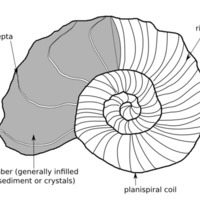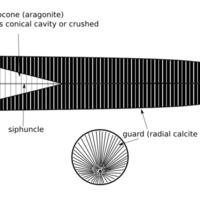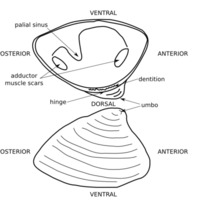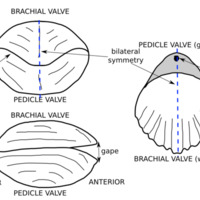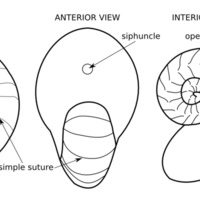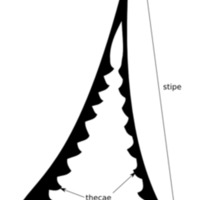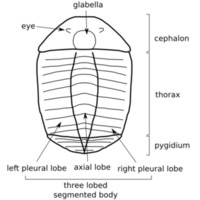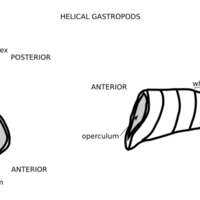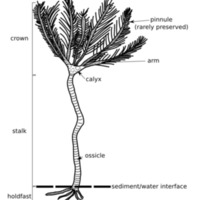- Home
- Rocks
- Type fossils
- Fossil Specimens
- Minerals
- Glossary
- Stratigraphic Chart
- Michel-Levy Chart
- Classification of igneous rocks
- University of Cambridge
- Department of Earth Sciences
- ESC Library
- Moodle
- Sedgwick Museum
- DoITPoMS
- Mindat.org
- Microfossils
- Bryozoans
- Webmineral
- Tree of Life
- CrystalMaker
- Virtual Microscope
Fossils
Title
Fossils
Description
Welcome to the fossils section of the website. This is designed to help you learn the different characteristics of each major fossil group so that you are able to distinguish between them.
First year students, please refer to the specimens housed in the first year teaching laboratory. There is no substitute for handling the specimens themselves; this website is just an accessory to help you along the way.
Animals occupy different environments, have different life habits and lived through different periods in geological time. It is good to be aware of these differences in lifestyle and timing, within and between phyla, classes, orders and families.
Collection Items
Ammonoid
Taxonomy
Phylum: Mollusca
Class: Cephalopoda
Subclass: Ammonoidea
Diagnostic features
[See labelled diagram above]
Aragonite shell
Septa
Suture (different for goniatites, ceratites and ammonites, see second diagram…
Belemnite
Taxonomy
Phylum: Mollusca
Class: Cephalopoda
Subclass: Coleoidea
Cohort: Belemnoidea
Diagnostic Features
Diagram with labelled features of belemnites
'Bullet' shape
Phragmocone: chambers divided by aragonitic septa (often preserved as conical…
Bivalve
Taxonomy
Phylum: Mollusca
Class: Bivalvia
Diagnostic features
Palial line/palial sinus
Adductor muscle scars
Growth lines
Dorsoventral symmetry (some exceptions, for example Gryphaea)
Two hinged valves
Umbo
Hinge
Gills (rarely…
Brachiopod
Taxonomy
Phylum: Brachiopoda
Diagnostic features
Two valves (brachial and pedicle)
Bilateral symmetry
Growth lines
Adductor and ductor muscle scars
Pedicle
Commissure
Gape
Teeth and socket (articulates; no teeth or socket in…
Coral
Taxonomy
Phylum: Cnidaria
Class: Anthozoa
Diagnostic features
Radial or biradial symmetry
External skeleton
Septa
Tabulae
Stratigraphic range
Ordovician to present
Tabulate, rugose: Ordovician to Permian (extinct at P/T extinction)
Scleractinian:…
Nautiloid
Taxonomy
Phylum: Mollusca
Class: Cephalopoda
Diagnostic features
Simple suture
Chambers
Central siphuncle
Straight, curved or coiled shell
Stratigraphic range
Cambrian to recent
Straight forms: Cambrian to Permian
Coiled forms: Devonian to…
Graptolite
Taxonomy
Phylum: Hemichordata
Class: Graptolithina
Diagnostic features
Stick-shape (often branched)
One or both edges may appear serrated
Thecae
Rhabdosome
Stipes
Stratigraphic range
Cambrian to Carboniferous (Dendroids)
Ordovician to Middle Devonian…
Trilobite
Taxonomy
Phylum: Arthropoda
Class: Trilobita
Distinctive features
Pygidium (tail)
Thorax (body)
Cephalon (head)
Paired appendages (not often preserved)
Three lobed longitudinal division of body (2x pleural, 1x axial)
Calcitic exoskeleton
Segmented…
Gastropod
Taxonomy
Phylum: Mollusca
Class: Gastropoda
Diagnostic Features
Coiled shell - planispiral or helical - consists of body whorl and spire
Mostly aragonitic shell
Shell consists of one large chamber (no septa)
Aperture
Siphonal notch
Way of…
Crinoid
Taxonomy
Phylum: Echinodermata
Class: Crinoidea
Diagnostic Features
Crown
Stalk
Pentaradial symmetry
Ossicles
Calyx
Pinnule
Holdfast
Way of life
Benthic (some pseudoplanktonic)
Filter feeders
Stratigraphic range
Ordovician to present
Advanced…

